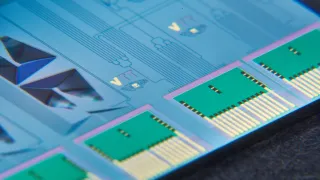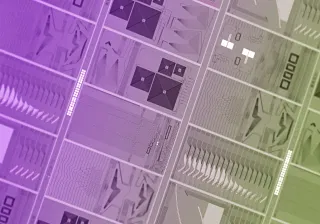VTT is the leading developer of silicon photonics in Finland. Various applications, from medicine to autonomous transport, can benefit from the high speed, energy-efficiency and microscopic size of silicon chips.
Imagine yourself in the remotest Lapland on a November night without any electric lights, a mobile phone or television. Not much fun, at least in the long run. Without light, life would be pretty gloomy and, without electricity, quite boring. It would also be inefficient, although it might feel relaxing at times.
Light in itself consists of electric and magnetic fields dancing in perfect harmony. Photonics, or in more lay terms, the science of light, is a field of technology which uses photons for purposes such as transferring data.
In our information society, the symbiosis of electricity and light keeps on getting more and more important. With the help of electricity, laser chips emit light pulses so short and dense that they enable feeding the data content of several HD films into an optical fibre as thick as a strand of a hair within one second.
In the future, data will be processed directly using light
The technological core of the current and future information society lies in tiny integrated circuits, ICs, pulsating inside sports watches as well as computers. Data centres, already much larger in size than traditional factories, are filled with millions of ICs without which we would not have, for instance, the internet as we know it. Even today, long fibre-optic networks carry the light into data centres and base stations for the mobile phone network.
So far, there have mostly been simple light signal transmitters and receivers at both ends of fibre cables, which transmit the messages via copper cables to the electronic ICs that do the actual data processing. In the future, light signals will come closer and closer to those ICs and, eventually, a substantial part of the actual data processing will be performed using light instead of electricity. Light brings more speed and energy efficiency to data transfer, which is important with a view to the future of information society and the whole planet. Direct use of photons in digital and quantum computing and analog signal processing has also become an important research area.
Silicon photonics technology developed by VTT lends itself to a range of applications, from medicine to autonomous transport
Silicon photonics (SiPh) can be used for a range of applications and for generating sustainable growth.
At VTT, we study and develop SiPh and photonic integrated circuits (PICs) based on it. The benefits of SiPh include the high speed and energy efficiency of components, and the small size of PICs. Instead of having an instrument the size of a cubic metre, you can have a measuring device no bigger than your fingertip.
At VTT, we have been developing SiPh in projects related to applications used for such purposes as data transfer, healthcare and smart mobility. For example, in collaboration with Rockley Photonics, we have been developing SiPh applicable to sensors that allow people to measure their own blood glucose or alcohol level, among other things. Tiny sensors can be worn in the form of smart clothes or watches which provide the wearers with extremely interesting data.
The technology is also part of the development of smart mobility systems at VTT. SiPh is used for developing laser radars that, for example, allow vehicles to measure their environment in 3D – even without any moving mirrors or other similar components. In other words, laser radars can improve traffic safety and enable self-driving cars. They can also be used for environmental measuring with the help of robots or drones.
In the symbiosis of electricity and light, the developers of microelectronics increasingly apply photonics. Correspondingly, it is time for photonics to learn something from the success story of ICs. By integrating photonics into PICs, we can develop the current technology further and provide totally new scientific, technological and business opportunities. Here at VTT, we do not yet necessarily recognise all the opportunities this technology can be applied to. That is quite an exciting idea in itself.
Finland has unique competence not only in photonics and SiPh but also in microelectronics and quantum technology. However, success in the international market and competitive state-of-the-art research require investments in both training within the sector and research equipment. In Finland, we should focus on our own strengths in SiPh based on micrometer-scale waveguides. It has its own unique advantages, strong synergies with other Finnish microsystem technologies (MEMS, quantum technology) and numerous applications. The future of SiPh in Finland looks bright – at least if we have the courage to invest in the field.
Read More
Photonic integrated circuits (PICs) minimise the cost, power consumption and size of wearable devices. In partnership with VTT, Rockley Photonics is developing pioneering sensors and taking them to mass production.






